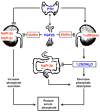Can features of phosphate toxicity appear in normophosphatemia?
- PMID: 22219005
- PMCID: PMC3804315
- DOI: 10.1007/s00774-011-0343-z
Can features of phosphate toxicity appear in normophosphatemia?
Abstract
Phosphate is an indispensable nutrient for the formation of nucleic acids and the cell membrane. Adequate phosphate balance is a prerequisite for basic cellular functions ranging from energy metabolism to cell signaling. More than 85% of body phosphate is present in the bones and teeth. The remaining phosphate is distributed in various soft tissues, including skeletal muscle. A tiny amount, around 1% of total body phosphate, is distributed both in the extracellular fluids and within the cells. Impaired phosphate balance can affect the functionality of almost all human systems, including muscular, skeletal, and vascular systems, leading to an increase in morbidity and mortality of the involved patients. Currently, measuring serum phosphate level is the gold standard to estimate the overall phosphate status of the body. Despite the biological and clinical significance of maintaining delicate phosphate balance, serum levels do not always reflect the amount of phosphate uptake and its distribution. This article briefly discusses the potential that some of the early consequences of phosphate toxicity might not be evident from serum phosphate levels.
Conflict of interest statement
Figures


Similar articles
-
Phosphate toxicity: new insights into an old problem.Clin Sci (Lond). 2011 Feb;120(3):91-7. doi: 10.1042/CS20100377. Clin Sci (Lond). 2011. PMID: 20958267 Free PMC article. Review.
-
Extracellular Phosphate, Inflammation and Cytotoxicity.Adv Exp Med Biol. 2022;1362:15-25. doi: 10.1007/978-3-030-91623-7_3. Adv Exp Med Biol. 2022. PMID: 35288869 Review.
-
Bone-kidney axis in systemic phosphate turnover.Arch Biochem Biophys. 2014 Nov 1;561:154-8. doi: 10.1016/j.abb.2014.06.031. Epub 2014 Jul 2. Arch Biochem Biophys. 2014. PMID: 24997362 Review.
-
Fibroblast growth factor 23 accelerates phosphate-induced vascular calcification in the absence of Klotho deficiency.Kidney Int. 2014 May;85(5):1103-11. doi: 10.1038/ki.2013.332. Epub 2013 Oct 2. Kidney Int. 2014. PMID: 24088960
-
Phosphate Metabolism in Health and Disease.Calcif Tissue Int. 2021 Jan;108(1):3-15. doi: 10.1007/s00223-020-00686-3. Epub 2020 Apr 7. Calcif Tissue Int. 2021. PMID: 32266417 Review.
Cited by
-
Effects of dietary phosphates from organic and inorganic sources on parameters of phosphorus homeostasis in healthy adult dogs.PLoS One. 2021 Feb 19;16(2):e0246950. doi: 10.1371/journal.pone.0246950. eCollection 2021. PLoS One. 2021. PMID: 33606750 Free PMC article.
-
Parkinson's Disease Etiology: Insights and Associations with Phosphate Toxicity.Int J Mol Sci. 2022 Jul 22;23(15):8060. doi: 10.3390/ijms23158060. Int J Mol Sci. 2022. PMID: 35897635 Free PMC article.
-
Effect of nickel on nutrient removal by selected indigenous protozoan species in wastewater systems.Saudi J Biol Sci. 2015 Mar;22(2):147-56. doi: 10.1016/j.sjbs.2014.09.010. Epub 2014 Sep 28. Saudi J Biol Sci. 2015. PMID: 25737645 Free PMC article.
-
Vitamin D and Phosphate Interactions in Health and Disease.Adv Exp Med Biol. 2022;1362:37-46. doi: 10.1007/978-3-030-91623-7_5. Adv Exp Med Biol. 2022. PMID: 35288871
-
The Source Matters-Effects of High Phosphate Intake from Eight Different Sources in Dogs.Animals (Basel). 2021 Dec 4;11(12):3456. doi: 10.3390/ani11123456. Animals (Basel). 2021. PMID: 34944233 Free PMC article.
References
-
- Slatopolsky E, Rutherford WE, Rosenbaum R, Martin K, Hruska K. Hyperphosphatemia. Clin Nephrol. 1977;7:138–146. - PubMed
-
- Gaasbeek A, Meinders AE. Hypophosphatemia: an update on its etiology and treatment. Am J Med. 2005;118:1094–1101. - PubMed
-
- Iotti S, Lodi R, Gottardi G, Zaniol P, Barbiroli B. Inorganic phosphate is transported into mitochondria in the absence of ATP biosynthesis: an in vivo 31P NMR study in the human skeletal muscle. Biochem Biophys Res Commun. 1996;225:191–194. - PubMed
-
- Hutson SM, Williams GD, Berkich DA, LaNoue KF, Briggs RW. A 31P NMR study of mitochondrial inorganic phosphate visibility: effects of Ca2+, Mn2+, and the pH gradient. Biochemistry. 1992;31:1322–1330. - PubMed
Publication types
MeSH terms
Substances
Grants and funding
LinkOut - more resources
Full Text Sources

